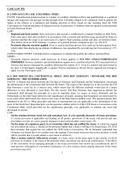1.1a) Significant risks of material misstatement at the financial statement level for the LS Group, for the
year ended 31 March 2023, include:
1. Risk of overstatement of revenue: The relaxation of credit policies may result in sales being recognized
before they are collectible. This risk is assessed as high, as it can have a significant impact on the
financial statements.
2. Risk of inventory misstatement: The acquisition of inventory from the subsidiary with higher margins
raises concerns about the valuation and existence of inventory. There is a risk of overstatement of
inventory or inventory obsolescence. This risk is assessed as moderate.
3. Risk of management override of controls: The CEO's daughter-in-law being the majority shareholder
and director of the subsidiary raises concerns about potential bias in financial reporting. There is a risk
that management could manipulate the financial statements to meet loan agreement requirements. This
risk is assessed as high.
b) The assessment of the significant risks will guide the auditor in determining the nature, timing, and
extent of audit procedures. Risks assessed as high will require more extensive audit procedures, while
risks assessed as moderate will require a reasonable level of testing. The identified risks indicate a higher
inherent risk in the financial statements, which would increase the overall audit risk.
1.2 The significant risks identified in 1.1a will affect the scope of the audit strategy for the LS Group. The
auditor will need to focus on obtaining sufficient and appropriate audit evidence related to revenue
recognition, inventory valuation, and management override of controls. The audit procedures will need
to be tailored to address these specific risks, including performing additional substantive testing, testing
controls over revenue and inventory, and obtaining corroborative evidence from external sources.
2. In working paper A1:
a) Each sampling factor will affect the sample size as follows:
- Population: The larger the population, the larger the sample size required.
- Sampling risk: Higher sampling risk will result in a larger sample size.
- Confidence level: Higher confidence level will require a larger sample size.
- Tolerable rate of deviation: A lower tolerable rate of deviation will require a larger sample size.
- Expected rate of deviation: A higher expected rate of deviation will require a larger sample size.
year ended 31 March 2023, include:
1. Risk of overstatement of revenue: The relaxation of credit policies may result in sales being recognized
before they are collectible. This risk is assessed as high, as it can have a significant impact on the
financial statements.
2. Risk of inventory misstatement: The acquisition of inventory from the subsidiary with higher margins
raises concerns about the valuation and existence of inventory. There is a risk of overstatement of
inventory or inventory obsolescence. This risk is assessed as moderate.
3. Risk of management override of controls: The CEO's daughter-in-law being the majority shareholder
and director of the subsidiary raises concerns about potential bias in financial reporting. There is a risk
that management could manipulate the financial statements to meet loan agreement requirements. This
risk is assessed as high.
b) The assessment of the significant risks will guide the auditor in determining the nature, timing, and
extent of audit procedures. Risks assessed as high will require more extensive audit procedures, while
risks assessed as moderate will require a reasonable level of testing. The identified risks indicate a higher
inherent risk in the financial statements, which would increase the overall audit risk.
1.2 The significant risks identified in 1.1a will affect the scope of the audit strategy for the LS Group. The
auditor will need to focus on obtaining sufficient and appropriate audit evidence related to revenue
recognition, inventory valuation, and management override of controls. The audit procedures will need
to be tailored to address these specific risks, including performing additional substantive testing, testing
controls over revenue and inventory, and obtaining corroborative evidence from external sources.
2. In working paper A1:
a) Each sampling factor will affect the sample size as follows:
- Population: The larger the population, the larger the sample size required.
- Sampling risk: Higher sampling risk will result in a larger sample size.
- Confidence level: Higher confidence level will require a larger sample size.
- Tolerable rate of deviation: A lower tolerable rate of deviation will require a larger sample size.
- Expected rate of deviation: A higher expected rate of deviation will require a larger sample size.










